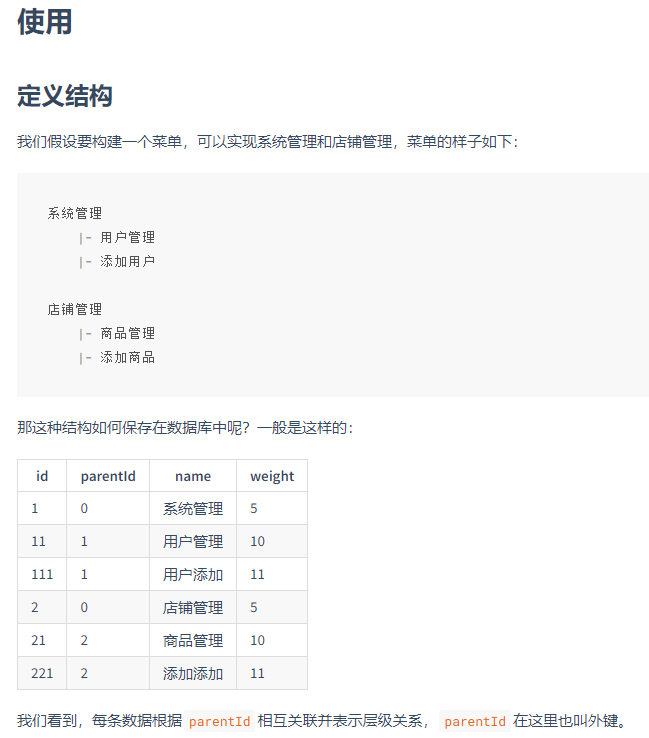推荐一个工具网站:Java代码生成平台
添加依赖:
<dependency>
<groupId>cn.hutool</groupId>
<artifactId>hutool-all</artifactId>
<version>5.8.1</version>
</dependency>Hutool官网
树结构工具-TreeUtil
官方示例:
构建tree:
// 构建node列表
List<TreeNode<String>> nodeList = CollUtil.newArrayList();
nodeList.add(new TreeNode<>("1", "0", "系统管理", 5));
nodeList.add(new TreeNode<>("11", "1", "用户管理", 222222));
nodeList.add(new TreeNode<>("111", "11", "用户添加", 0));
nodeList.add(new TreeNode<>("2", "0", "店铺管理", 1));
nodeList.add(new TreeNode<>("21", "2", "商品管理", 44));
nodeList.add(new TreeNode<>("221", "2", "商品管理2", 2));TreeNode表示一个抽象的节点,也表示数据库中一行数据。 如果有其它数据,可以调用setExtra添加扩展字段。
// 0表示最顶层的id是0
List<Tree<String>> treeList = TreeUtil.build(nodeList, "0");因为两个Tree是平级的,再没有上层节点,因此为List。
自定义字段名:
//配置
TreeNodeConfig treeNodeConfig = new TreeNodeConfig();
// 自定义属性名 都要默认值的
treeNodeConfig.setWeightKey("order");
treeNodeConfig.setIdKey("rid");
// 最大递归深度
treeNodeConfig.setDeep(3);
//转换器
List<Tree<String>> treeNodes = TreeUtil.build(nodeList, "0", treeNodeConfig,
(treeNode, tree) -> {
tree.setId(treeNode.getId());
tree.setParentId(treeNode.getParentId());
tree.setWeight(treeNode.getWeight());
tree.setName(treeNode.getName());
// 扩展属性 ...
tree.putExtra("extraField", 666);
tree.putExtra("other", new Object());
});通过TreeNodeConfig我们可以自定义节点的名称、关系节点id名称,这样就可以和不同的数据库做对应。
使用实例:
@Data
@NoArgsConstructor
@AllArgsConstructor
public class AClothClassVo {
private Integer id;
private String name;
private Integer pid;
private Integer status;
private String desc;
// 子目录列表
private List<AClothClassVo> treeNode;
public static void main(String[] args) {
// 构建数据
List<AClothClassVo> lists = CollUtil.newArrayList();
lists.add(new AClothClassVo(1, "顶级目录1", 0, 1, "父目录01", null));
lists.add(new AClothClassVo(2, "顶级目录2", 0, 1, "父目录02", null));
lists.add(new AClothClassVo(3, "顶级目录3", 0, 1, "父目录03", null));
lists.add(new AClothClassVo(4, "二级目录4", 1, 1, "父目录01的子类", null));
lists.add(new AClothClassVo(5, "三级目录5", 4, 1, null, null));
lists.add(new AClothClassVo(6, "四级目录6", 5, 1, null, null));
lists.add(new AClothClassVo(7, "二级目录7", 2, 1, "父目录01的子类7", null));
lists.add(new AClothClassVo(8, "二级目录8", 2, 1, "父目录01的子类8", null));
lists.add(new AClothClassVo(9, "三级目录9", 4, 1, null, null));
TreeNodeConfig config = new TreeNodeConfig();
// 树形数据中id的属性名,写成id1方便区分,实际上写AClothClassVo实体类的id属性名
config.setIdKey("id1");
// 展示目录深度,数据中一共四级目录
config.setDeep(2);
/**
* 入参
* tree: 最终要返回的数据
* node: lists数据
*
* 返回
* Tree<String>
* Tree: 转换的实体 为数据源里的对象类型
* String: ID类型
*
*/
List<Tree<String>> list = TreeUtil.build(lists, "0", config, (node, tree) -> {
tree.setId(node.getId().toString());
tree.setName(node.getName());
tree.setParentId(node.getPid().toString());
// 额外的值
tree.put("status", node.getStatus());
tree.put("desc", node.getDesc());
});
System.out.println(JSON.toJSONString(list));
}
}
返回数据:
[
{
"id1":"1",
"name":"顶级目录1",
"parentId":"0",
"status":1,
"desc":"父目录01",
"children":[
{
"id1":"4",
"name":"二级目录4",
"parentId":"1",
"status":1,
"desc":"父目录01的子类"
}
]
},
{
"id1":"2",
"name":"顶级目录2",
"parentId":"0",
"status":1,
"desc":"父目录02",
"children":[
{
"id1":"7",
"name":"二级目录7",
"parentId":"2",
"status":1,
"desc":"父目录01的子类7"
},
{
"id1":"8",
"name":"二级目录8",
"parentId":"2",
"status":1,
"desc":"父目录01的子类8"
}
]
},
{
"id1":"3",
"name":"顶级目录3",
"parentId":"0",
"status":1,
"desc":"父目录03"
}
]



